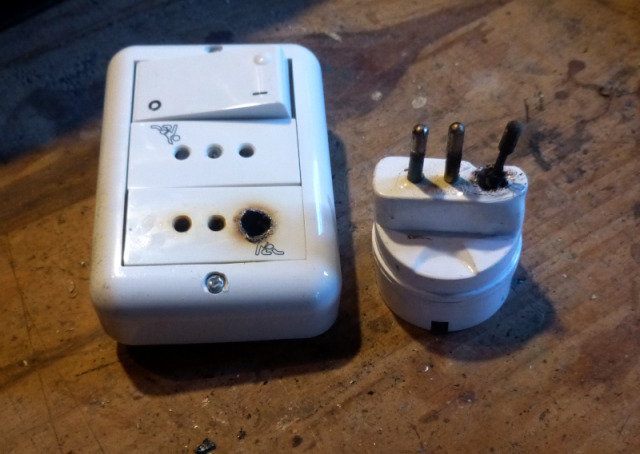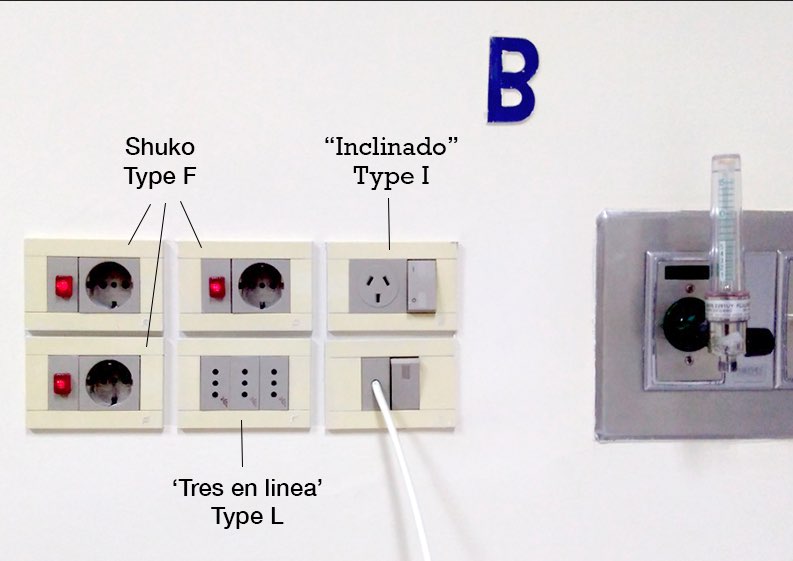
And what would it look like if done today?
An inquisitive old fart with a camera

And what would it look like if done today?

I saw this on the Faceborg recently and saw this in an Uruguay Expat Group.
Later I was standing near a house on the dog walk where I usually spend about ten minutes, and have hundreds of times, noticing its outdoor wiring for the first time.

Sure, just bring the current into the house through a wire lying on the lawn. Just pass over it with the lawn mower when you need to. No problem!


I’ve gotten back into infrared saunas, perhaps ironic now that spring is here. But when I come back after it’s been warming, there’s a burning-plastic sort of smell I can’t quite place. Yesterday, a few minutes in, the sauna turned itself off. Power outage? I hit the button and it came back on. And then I heard it.
So, off to the electrical store tomorrow. Why the adapter? When we first got here, I immediately replaced the Schuko plugs on several new appliances with tres-en-linea (above). But then it occurred to me that it might void the warranty. I’ll replace the two ruined t-e-l with one Shucko.
It’s been a long time since I introduced the subject of electrical outlets in Uruguay. A visit to the hospital reminded me of their wonderful weirdness here.

Shuko is common in Europe; “Inclinado” the standard in neighboring Argentina, and “Tres en linea,” my favorite, apparently the standard in Uruguay. But when your whole country is 3-1/2 million people, who – meaning people manufacturing electrical appliances for worldwide sales – particularly cares?
And of course, if you’re installing signs in Uruguay, who particularly cares that you glue the capital B to the wall upside and backwards?
Which perhaps has you thinking, I want to visit your wonderful little country. What should I do about my electrical needs?
The obvious answer is to throw your hands up in despair, and leave all your damned gadgets at home.
Or just stop by our place.

I probably have your needs covered.

We had episodes like this all day. Then I heard simultaneous zapping noises from the line outside. A friend called the electric company for us and explained it was centelleando (sparking, which she said would get them here quickly, and sure enough within thirty minutes a brand new UTE Ford pickup appeared. I pointed toward the line and that’s where I heard it. Up ladder, new connector, and chau. All normal again.
At our place in the country, a low-hanging power line would have been dangerous for anyone trying to pass to the back of the property with a machine. After months — years? — UTE, the state electric company, got around to responding to the work order(s) to raise it

I wasn’t there yesterday, but apparently the task involved four trucks and about ten workers, only one of whom was actually doing anything. The power pole was for the next street, so why other trucks came up our street so nine workers could watch one work — ? Ahh, the mysteries….
 |
| A) Inclinado – B) Tres-en-linea (three in line) – C) Schuko (German) |
Buy three appliances in Uruguay, and you may get three different types of plug.
If you do some of your own wiring, note that a mounting frame D from Argentina will not work with sockets from Uruguay (A & B), and vice versa. The width discrepancy amounts to a millimeter or less – way to go, guys! And (of course) Argentinian hardware is not widely sold in Uruguay. We bought our house from someone who built it with (cheaper) hardware he carried from Buenos Aires, which is why I know.
I like the compact tres-en-linea, especially with hot leads partially insulated (plug B). I have cut off perfectly good Schuko plugs and rewired new appliances right out of the box.
Other people prefer fumbling with adapters. Here’s one that will accept anything, including North American plugs:
But the question remains – what’s on the other end that plugs into the wall?